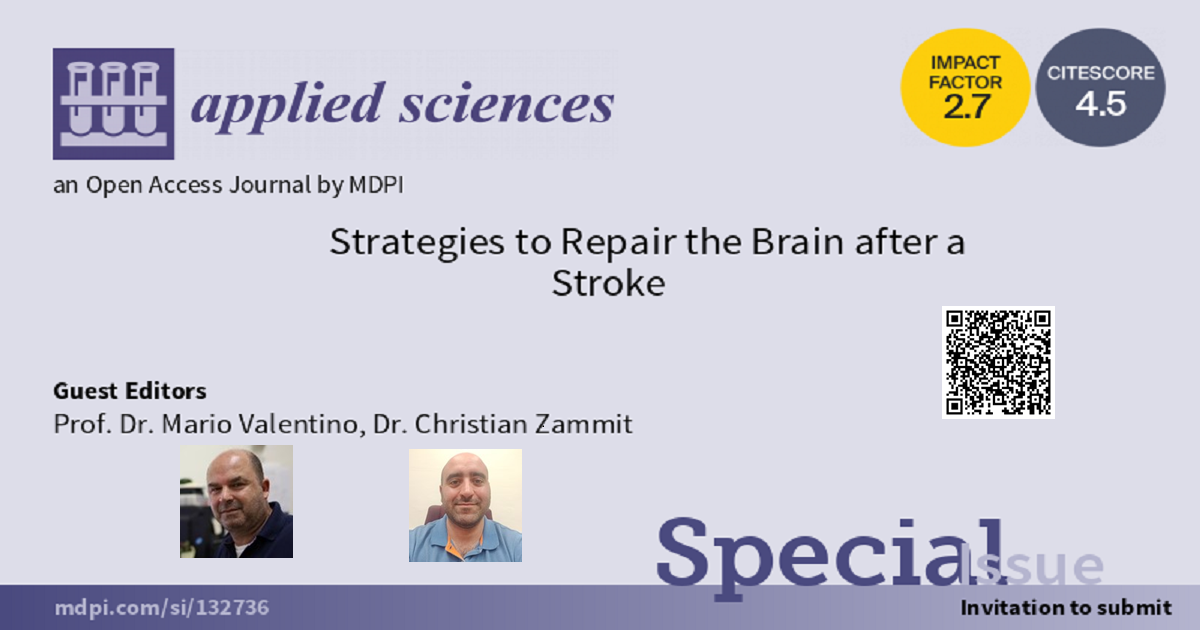Strategies to Repair the Brain after a Stroke
A special issue of Applied Sciences (ISSN 2076-3417). This special issue belongs to the section "Applied Biosciences and Bioengineering".
Deadline for manuscript submissions: closed (30 September 2023) | Viewed by 624

Special Issue Editors
Interests: stroke and neurovascular coupling; white matter injury; brain injury and repair; rodent models of stroke; two-photon imaging of live rodent brain; neuroprotection; spinal cord and traumatic brain injury
Special Issues, Collections and Topics in MDPI journals
Interests: stroke; white matter injury; neonatal hypoxia ischemia; live brain slice imaging; electrophysiology; two-photon microscopy
Special Issues, Collections and Topics in MDPI journals
Special Issue Information
Dear Colleagues,
The treatment of stroke has been crippled for many years by the complexity of the brain’s response and promising but failed therapies. Tissue plasminogen activator is considered to be the only gold standard for the approved treatment of stroke, and when promptly administered, it can reduce the long-term morbidity and prevent long-term disability. An urgent need therefore exists for new therapies for the majority of patients beyond the current narrow treatment window. New advances in imaging and rehabilitation have shown, in both animal models and in humans, that the brain can compensate for function lost as a result of stroke through spontaneous reorganization of intact circuits and through novel treatment-induced mechanisms. The best understanding of functional recovery comes from studies of the primary motor cortex, where force generation and accuracy of movement can be measured reliably over time after focal damage.
The main aim of this Special Issue is to underline the recent progress in the field of brain repair after stroke to gain a solid understanding of emerging therapies. Developments in basic neuroscience have produced various potential therapies for brain repair after a stroke such as stem-cell, glial and primary neuronal transplantation, use-dependent plasticity, trophic factors, strategies for axon regeneration, robotics, stimulation, constrained-induced physical therapy, and cognitive approaches.
For this Special Issue, we particularly welcome high-quality research articles (original research papers and reviews) from human and animal models of stroke recovery so as to provide a comprehensive update of this emerging science in order to bridge the gap between basic life science research findings and the clinical perspective.
Prof. Dr. Mario Valentino
Dr. Christian Zammit
Guest Editors
Manuscript Submission Information
Manuscripts should be submitted online at www.mdpi.com by registering and logging in to this website. Once you are registered, click here to go to the submission form. Manuscripts can be submitted until the deadline. All submissions that pass pre-check are peer-reviewed. Accepted papers will be published continuously in the journal (as soon as accepted) and will be listed together on the special issue website. Research articles, review articles as well as short communications are invited. For planned papers, a title and short abstract (about 100 words) can be sent to the Editorial Office for announcement on this website.
Submitted manuscripts should not have been published previously, nor be under consideration for publication elsewhere (except conference proceedings papers). All manuscripts are thoroughly refereed through a single-blind peer-review process. A guide for authors and other relevant information for submission of manuscripts is available on the Instructions for Authors page. Applied Sciences is an international peer-reviewed open access semimonthly journal published by MDPI.
Please visit the Instructions for Authors page before submitting a manuscript. The Article Processing Charge (APC) for publication in this open access journal is 2400 CHF (Swiss Francs). Submitted papers should be well formatted and use good English. Authors may use MDPI's English editing service prior to publication or during author revisions.
Keywords
- neurons
- glia
- white matter
- axon regeneration
- reconstructive techniques
- physical therapy
- speech therapy
- language therapy
- plasticity
- remyelination
- neurotrophic factors
- stem cells
- brain stimulation
- neuroprotection
- imaging






